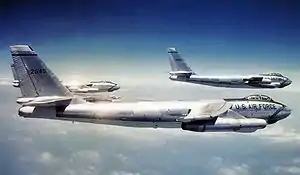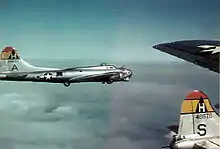368th Training Squadron
The 368th Training Squadron is a United States Air Force ground training unit, located at Fort Leonard Wood, Missouri. The squadron reports to the 782d Training Group, part of the 82d Training Wing, at Sheppard Air Force Base, Texas and conducts training for airmen in civil engineering, (including Engineering Assistant, Pavement and Equipment, and Emergency Management) as well as in Logistics Readiness in Ground Transportation.
| 368th Training Squadron | |
|---|---|
 B-47E Stratojets of the 306th Bombardment Wing[note 1] | |
| Active | 1942–1946; 1947–1974; 2018–present |
| Country | |
| Branch | |
| Role | Training |
| Part of | 782d Training Group, 82d Training Wing |
| Garrison/HQ | Fort Leonard Wood |
| Engagements | European Theater of Operations[1] |
| Decorations | Distinguished Unit Citation Air Force Outstanding Unit Award[1] |
| Insignia | |
| 368th Bombardment Squadron emblem (approved 26 August 1942)[1] |  |
| World War II fuselage code[2][note 2] | BO |
The squadron was first activated in 1942 as the 368th Bombardment Squadron. After training in the United States, it became one of the first units to deploy to the European Theater of Operations to participate in the strategic bombing campaign against Germany. earning two Distinguished Unit Citations. After V-E Day, the squadron remained in Europe and participated in the photographic mapping of Europe and Africa until it was inactivated in 1946.
The squadron was reactivated in 1947 and served as a medium bomber unit with Strategic Air Command (SAC) until inactivating in 1963, as SAC drew down its medium bomber force.
History
World War II

The squadron was established as a Boeing B-17 Flying Fortress heavy bomber unit in early 1942. Trained under Second Air Force before deploying to England in September 1942, it became one of the first heavy bomber squadrons of the VIII Bomber Command 1st Bombardment Division. It was a highly decorated squadron during the air offensive over Nazi Germany and occupied Europe, engaging in strategic bombardment operations until the end of the war in Europe, in April 1945. After the war, the squadron assisted in demobilizing personnel using B-17s as transports along Air Transport Command routes from Western Europe, Italy and the United Kingdom to Gibraltar, and north and west Africa.
The 368th was reassigned to United States Air Forces in Europe occupation forces in late 1945, engaging in photographic mapping and strategic reconnaissance operations over Western occupation zones of Germany as well as the Soviet zone. Moved to Istres-Le Tubé Air Base, France, it absorbed parts of demobilized squadrons and then returned to Germany as part of the American occupation forces. It was demobilized in Germany at the end of 1946.
Strategic Air Command
Reactivated as a Strategic Air Command (SAC) Boeing B-29 Superfortress squadron at MacDill AFB, Florida in 1948, the squadron began upgrading to the new Boeing B-50 Superfortress, an advanced version of the B-29, in 1950. The B-50 gave the unit the capability to carry heavy loads of conventional weapons faster and farther; it was also designed for atomic bomb missions if necessary.
The squadron began receiving the first production models of the new Boeing B-47 Stratojet jet bomber in 1951 and despite initial difficulties, the Stratojet became the mainstay of the medium-bombing strength of SAC all throughout the 1950s. It began sending its B-47s to Aerospace Maintenance and Regeneration Center at Davis-Monthan Air Force Base in 1963 when the aircraft was deemed no longer capable of penetrating Soviet airspace. The 368th was not operational from 3 January through 1 April 1963.
Training unit
The Air Force had begun training certain civil engineering skills at Fort Leonard Wood, Missouri in the 1970s. After 1992, additional Air Force training in emergency management and ground transportation was moved to Fort Leonard Wood as well, with Detachment 1, 364th Training Squadron acting as the manager for this training. Eventually, the detachment became the largest in the Air Force, and in early 2018 Air Education and Training Command decided to expand the detachment and replace it with a full squadron. The squadron was redesignated the 368th Training Squadron and absorbed the personnel and equipment of the detachment in a ceremony on 17 October 2018.[3]
Lineage
- Constituted as the 368th Bombardment Squadron (Heavy) on 28 January 1942
- Activated on 1 March 1942
- Redesignated 368th Bombardment Squadron, Heavy on 20 August 1943[4]
- Inactivated on 25 December 1946
- Redesignated 368th Bombardment Squadron, Very Heavy on 11 June 1947
- Activated on 1 July 1947
- Redesignated 368th Bombardment Squadron, Medium on 11 August 1948
- Inactivated on 1 April 1963[5]
- Redesignated 368th Training Squadron
- Activated c. 17 October 2018[3]
Assignments
- 306th Bombardment Group, 1 March 1942 – 25 December 1946
- 306th Bombardment Group, 1 July 1947 (attached to 306th Bombardment Wing after 10 February 1951)[6]
- 306th Bombardment Wing, 16 June 1952 – 1 April 1963[6]
- 782d Training Group, c. 17 October 2018[7]
Stations
|
|
Aircraft
- Boeing B-17 Flying Fortress, 1942–1946
- Boeing B-29 Superfortress, 1948–1951
- Boeing B-50 Superfortress, 1950–1951
- Boeing B-47 Stratojet, 1951–1963[5]
References
Notes
- Explanatory notes
- Aircraft in foreground is Boeing B-47E-95-BW Stratojet, serial 52-545. That aircraft was retired to The Military Aircraft Storage and Disposition Center on 19 November 1965.
- The 368th emblem was designed by B-17 gunner Thomas Albert Donlon, Jr., of the bomber "Lady Winifred".
- Citations
- Maurer, Combat Squadrons, pp. 455-456
- Watkins, pp. 56-57
- Ingle, John (17 October 2018). "368th TRS replaces largest AETC detachment at ceremony". Air Force History Index. Retrieved 21 November 2018.
- See Haulman, Daniel L. (17 March 2017). "Factsheet 306 Flying Training Group (AETC)". Air Force Historical Research Agency. Retrieved 21 November 2018. (date group redesignated)
- Lineage information, including stations and aircraft, through March 1963 in Maurer, Combat Squadrons, pp. 455-456, except as noted.
- Ravenstein, pp. 151-153
- See Ingle (782d Group requested upgrade of detachment to squadron0
- Station number in Anderson.
- Station number in Johnson.
- See Ravenstein, pp. 151-153 (306th Wing station)
Bibliography
![]() This article incorporates public domain material from the Air Force Historical Research Agency website http://www.afhra.af.mil/.
This article incorporates public domain material from the Air Force Historical Research Agency website http://www.afhra.af.mil/.
- Anderson, Capt. Barry (1985). Army Air Forces Stations: A Guide to the Stations Where U.S. Army Air Forces Personnel Served in the United Kingdom During World War II (PDF). Maxwell AFB, AL: Research Division, USAF Historical Research Center. Archived from the original (PDF) on 23 January 2016. Retrieved 28 June 2017.
- Freeman, Roger A. (1970). The Mighty Eighth: Units, Men and Machines (A History of the US 8th Army Air Force). London, England, UK: Macdonald and Company. ISBN 978-0-87938-638-2.
- Maurer, Maurer, ed. (1983) [1961]. Air Force Combat Units of World War II (PDF) (reprint ed.). Washington, DC: Office of Air Force History. ISBN 0-912799-02-1. LCCN 61060979. Retrieved 17 December 2016.
- Maurer, Maurer, ed. (1982) [1969]. Combat Squadrons of the Air Force, World War II (PDF) (reprint ed.). Washington, DC: Office of Air Force History. ISBN 0-405-12194-6. LCCN 70605402. OCLC 72556. Retrieved 17 December 2016.
- Ravenstein, Charles A. (1984). Air Force Combat Wings, Lineage & Honors Histories 1947-1977. Washington, DC: Office of Air Force History. ISBN 0-912799-12-9. Retrieved 17 December 2016.
- Watkins, Robert (2008). Battle Colors: Insignia and Markings of the Eighth Air Force In World War II. Vol I (VIII) Bomber Command. Atglen, PA: Shiffer Publishing Ltd. ISBN 0-7643-1987-6.